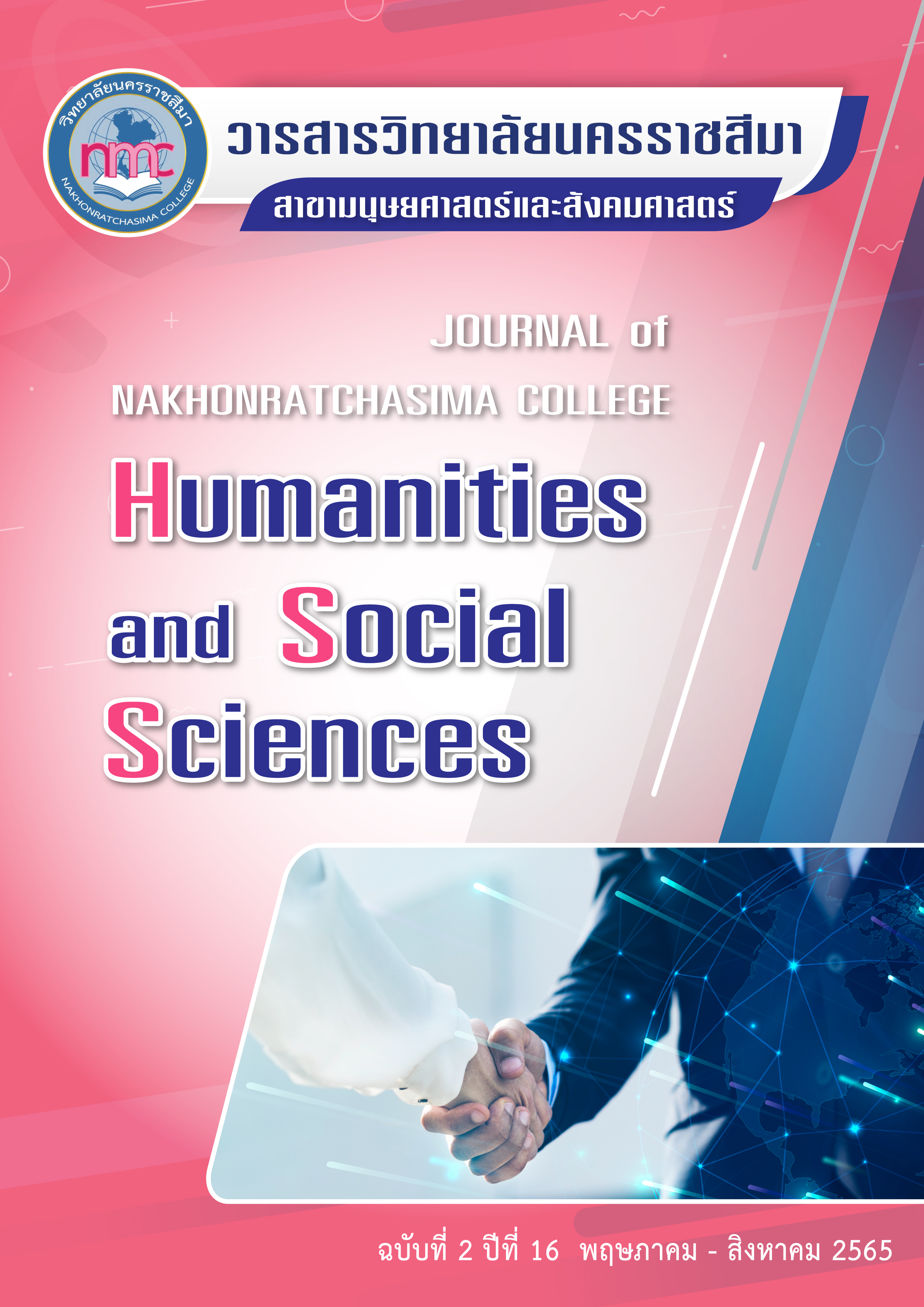ปัจจัยเชิงสาเหตุที่ส่งผลต่อผลการดำเนินงานของวิสาหกิจขนาดกลางและขนาดย่อม (SMEs) ในภาคตะวันออกเฉียงเหนือ
Causal Factors Affecting The Performance of Small And Medium Enterprises (SMEs) in The Northeast Region
คำสำคัญ:
ความสามารถด้านโครงสร้างพื้นฐานความรู้, การจัดการความรู้, ความคล่องตัว, ผลการดำเนินงานบทคัดย่อ
งานวิจัยนี้มีวัตถุประสงค์เพื่อ 1) พัฒนาแบบจำลองปัจจัยความสามารถด้านโครงสร้างพื้นฐานความรู้ กระบวนการจัดการความรู้ ความคล่องตัวขององค์กร ที่ส่งผลต่อผลการดำเนินงานของวิสาหกิจขนาดกลางและขนาดย่อม (SMEs) ในภาคตะวันออกเฉียงเหนือ 2) วิเคราะห์อิทธิพลทางตรงและอิทธิพลทางอ้อมของความสามารถด้านโครงสร้างพื้นฐานความรู้ กระบวนการจัดการความรู้ ความคล่องตัวขององค์กร ที่ส่งผลต่อผลการดำเนินงานของวิสาหกิจขนาดกลางและขนาดย่อม ในภาคตะวันออกเฉียงเหนือโดยทำการเก็บข้อมูลจากผู้ประกอบการ SMEs จำนวน 386 คน ใช้แบบสอบถามเป็นเครื่องมือในการวิจัย และใช้สถิติการวิเคราะห์แบบจำลองสมการโครงสร้าง
ผลการศึกษาพบว่า
1. แบบจำลองปัจจัยความสามารถด้านโครงสร้างพื้นฐานความรู้ กระบวนการจัดการความรู้ ความคล่องตัวขององค์กร ส่งผลต่อผลการดำเนินงานของวิสาหกิจขนาดกลางและขนาดย่อม (SMEs) ในภาคตะวันออกเฉียงเหนือ โมเดลมีความกลมกลืนกับข้อมูลเชิงประจักษ์เชิงสัมพัทธ์ โดยมีค่าสถิติ CMIN/df = 1.213 p-value = 0.123 ค่าดัชนีตรวจสอบความกลมกลืน GFI = 0.975, AGFI = 0.951, CFI = 0.999, NFI = 0.992 และค่าความคลาดเคลื่อนของการประมาณ RMSEA = 0.024, RMR = 0.002 ซึ่งความสามารถด้านโครงสร้างพื้นฐานความรู้ กระบวนการจัดการความรู้ และความคล่องตัวขององค์กร สามารถร่วมกันอธิบายผลการดำเนินงานขององค์กรได้ร้อยละ 98
2. ความสามารถด้านโครงสร้างพื้นฐานความรู้มีอิทธิพลทางตรงเชิงบวกต่อความคล่องตัวขององค์กร กระบวนการจัดการความรู้ และผลการดำเนินงานขององค์กร ซึ่งความสามารถด้านโครงสร้างพื้นฐานความรู้มีอิทธิพลทางอ้อมต่อผลการดำเนินงานขององค์กรโดยผ่านความคล่องตัวขององค์กร และกระบวนการจัดการความรู้
เอกสารอ้างอิง
กรมพัฒนาธุรกิจการค้า. (2564). รายชื่อนิติบุคคลจัดตั้งใหม่และเลิกปี 2564. สืบค้นเมื่อวันที่ 10 สิงหาคม 2564, จากhttps://www.dbd.go.th/news_view.php?nid=469412361
กัลยา วานิชย์บัญชา. (2557). การวิเคราะห์สมการโครงสร้าง (SEM) ด้วย AMOS. กรุงเทพฯ : สามลดา.
ตวงพร สิงโต. (2564). ผลการสำรวจ SMEs ที่ได้รับผลกระทบจากสถานการณ์การแพร่ระบาดของโรคติดเชื้อไวรัสโคโรนา 2019 (COVID-19) ระลอกที่ 3. ฝ่ายวิเคราะห์สถานการณ์และเตือนภัยทางเศรษฐกิจ. สำนักงานส่งเสริมวิสาหกิจขนาดกลางและขนาดย่อม. สืบค้นเมื่อวันที่ 10 สิงหาคม 2564, จาก https://www.sme.go.th/upload/mod_download/download-20210702152604.pdf
สุมาลี บุญเรือง และศราวุธ สังข์วรรณะ. (2560). ปัจจัยที่ส่งผลต่อการจัดการความรู้ของ มหาวิทยาลัยมหาจุฬาลงกรณราชวิทยาลัย. วารสาร มจร สังคมศาสตร์ปริทรรศน์, 6(4), 225-237.
สำนักงานส่งเสริมวิสาหกิจขนาดกลางและขนาดย่อม. (2560). แผนการส่งเสริม SME ฉบับที่ 4 (พ.ศ.2560-2564). ฝ่ายนโยบายและแผนส่งเสริมSME. สืบค้นเมื่อวันที่ 10 สิงหาคม 2564, จากhttps://www.sme.go.th/th/download.php?modulekey=12
Abbas, A. R. & Taha, J. (2019). The Effect of Infrastructure Capabilities of Knowledge Management and Business Strategy on Organizational Performance through the Mediating Variable of Knowledge Management Process Capabilities. Scientific Journal of Strategic Management of Organizational Knowledge Summer 2019, 2(5), 173 – 208.
Albert Surya Wanasida, Innocentius Bernarto, Niko Sudibjo Agus Purwanto. (2021). The Role of Business Capabilities in Supporting Organization Agility and Performance During the COVID-19 Pandemic: An Empirical Study in Indonesia. Journal of Asian Finance, Economics and Business, 8(5), 0897–0911
Cronbarch, L. J. (1990). Essential of Psychology Testing. 5thed. New York: Harper and Row Publishers Inc.
Diamantopoulos, A. & Siguaw, J. A., (2000). Introduction to LISREL: A guide for the uninitiated. London: SAGE Publications, Inc,.
Gold, A. H., Malhotra, A., & Segars, A. H. (2001). Knowledge management: An organizational capabilities perspective. Journal of Management Information Systems, 18(1), 185-214.
Hair, J. F., Risher, J. J., Sarstedt, M., & Ringle, C. M. (2019). When to use and how to report the results of PLS-SEM. European Business Review, 31(1), 2–24.
Harsch, K. and Festing, M. (2020). Dynamic talent management capabilities and organizational agility—a qualitative exploration. Human Resource Management, 59(1), 43-61.
Kaplan, R.S. & Norton, D.P. (1996). The Balanced Scorecard: Translating Strategy Into Action. Boston: Harvard Business School Press.
Manfredi, L. V., Frattini, F., Messeni, P. A., & Berner, M. (2019). Knowledge management and knowledge transfer in arts and crafts organizations: evidence from an exploratory multiple case-study analysis. Journal of Knowledge Management, 23(7), 1335-1354.
Mozhayeva, T., Simkin, A., Sorokina, E. and Proskurin, A. (2019). Management of personnel risks in the organization quality management system. Paper Presented at the IOP Conference Series: Materials Science and Engineering.
Nonaka, I. (1994). A dynamic theory of organizational knowledge creation. Organization Science, 5(1), 14-37.
Nosheen Rafi and Alia Ahmed, Imran Shafique, Masood Nawaz Kalyar. (2021). Knowledge management capabilities and organizational agility as liaisons of business performance. South Asian Journal of Business Studies. Emerald Publishing Limited, 2398-628X.
Queiroz, M., Tallon, P.P., Sharma, R., & Coltman, T. (2018). The role of IT application orchestration capability in improving agility and performance. The Journal of Strategic Information Systems, 27(1), 4-21.
Rovinelli, R. J., & Hambleton, R. K. (1997). On the use of content specialists in the assessment of criterion referenced test item validity. Dutch Journal of Educational Research, 2, 49-60.
Sen, L., TS, C.F., Junai, Y. and Ben, N. (2018). Understanding the effect of cloud computing on organizational agility: an empirical examination. International Journal of Information Management, 43, 98-111.
Shahzad, M., Qu, Y., Zafar, A.U., Rehman, S.U. & Islam, T. (2020). Exploring the influence of knowledge management process on corporate sustainable performance through green innovation. Journal of Knowledge Management, 24(9), 2079-2106.
Sharifi, H., & Zhang, Z. (1999). A methodology for achieving agility in manufacturing organizations, An introduction. International Journal of Production Economics, 62(1-2), 7-22.
Tahir, M. N. H. B. (2020). Knowledge captured as an innovation factor: The application and usage of information and communication technology in the Malaysian public sector. ResearchGate, 1-9.
ดาวน์โหลด
เผยแพร่แล้ว
รูปแบบการอ้างอิง
ฉบับ
ประเภทบทความ
สัญญาอนุญาต
จรรยาบรรณผู้เขียนบทความ
ผู้เขียนบทความต้องรับรองว่าบทความนี้ไม่เคยตีพิมพ์ในวารสารใดหรือสิ่งพิมพ์อื่นๆ มาก่อน ต้องไม่คัดลอกผลงานผู้อื่นมาปรับแต่งเป็นบทความของตน และไม่ได้อยู่ระหว่างการเสนอเพื่อพิจารณาตีพิมพ์ อีกทั้งยอมรับหลักเกณฑ์การพิจารณาและการตรวจแก้ไขบทความต้นฉบับโดยกองบรรณาธิการวารสารวิทยาลัยนครราชสีมา สาขามนุษยศาสตร์และสังคมศาสตร์
บทความทุกเรื่องได้รับการตรวจพิจารณาทางวิชาการโดยผู้ทรงคุณวุฒิที่มีประสบการณ์และมีความเชี่ยวชาญตรงตามสาขาของบทความ ซึ่งผู้เขียนต้องแก้ไขตามคำแนะนำของผู้ทรงคุณวุฒิภายในระยะเวลาที่กำหนด หากไม่เป็นไปตามกำหนดกองบรรณาธิการขอสงวนสิทธิ์และยกเลิกการตีพิมพ์โดยจะแจ้งให้ทราบต่อไป
ข้อความที่ปรากฏในบทความของวารสารนี้เป็นความคิดเห็นของผู้เขียนซึ่งไม่เกี่ยวข้องกับวิทยาลัยนครราชสีมาแต่อย่างใด และกองบรรณาธิการขอสงวนสิทธิ์ในการพิจารณาและตรวจประเมินบทความเพื่อตีพิมพ์ในวารสารของวิทยาลัยนครราชสีมา สาขามนุษยศาสตร์และสังคมศาสตร์



